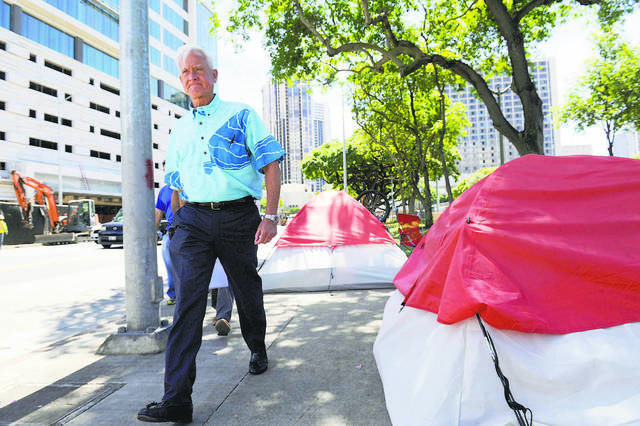Committee OKs plan for homeless, with conditions

BRUCE ASATO / BASATO@STARADVERTISER.COM
Mayor Caldwell held a news conference on the matter on a sidewalk at Aala Park, Monday, October 1, 2018, where homeless encampments nearly make pedestrian traffic impassable, as he has to avoid tents while walking on the sidewalk.
A key Honolulu City Council committee Tuesday gave Mayor Kirk Caldwell a preliminary green light to enforce the Sidewalk Obstruction and No Lodging ordinances that were signed into law nearly two months ago.
The bad news for Caldwell is that the Public Works, Infrastructure and Sustainability Committee also wants to insert language into Resolution 18-280 Opens in a new tab instructing his administration to not transport homeless individuals in need of services or shelter outside of the districts, or some other geographical area, where they are picked up.
Caldwell, in response, said such a stipulation could render the no-lodging law, or possibly both laws, unworkable and possibly unconstitutional.
Clarity on the issue is expected today when the full Council meets to consider approval of the resolution, which accepts the latest update of the city’s homeless action plan.
The no-lodging bill requires city officers to ensure there is available shelter space and then provide a ride to an individual before issuing a citation to a violator.
PWIS Chairwoman Carol Fukunaga told colleagues she and other Council members are worried that the new requirement would unfairly burden those areas with the most shelters and services for the homeless.
Don't miss out on what's happening!
Stay in touch with breaking news, as it happens, conveniently in your email inbox. It's FREE!
Councilwoman Kymberly Pine has said repeatedly that city workers are driving homeless individuals to shelters along the Waianae coast, in effect shifting the burden of dealing with homeless issues to constituents in her West Oahu district. Administration officials, in response, said those who are being transported to West Oahu shelters asked to go there on their own.
“The goal from our standpoint is within each Council district the services and shelter alternatives really should be made available there,” Fukunaga said. “The goal is, within each region we do have to come up with what works best within a region.”
Asked after the meeting to clarify, Fukunaga said Council members have consistently raised concerns about the shifting of the homeless into less populated areas.
But Caldwell told reporters he’s bothered by any requirement prohibiting the administration from transporting people where they want to go and believes the idea may be unconstitutional.
It’s also not practical, he said, adding that “sometimes you gotta move those who are addicted as far away as possible from where they’re getting the source of their addiction — their drugs or alcohol,” Caldwell said.
The mayor and the Council have been tangling over homeless policies for months.
For years the administration rejected the notion of an islandwide sit-lie ban, citing constitutional issues, instead supporting sit-lie prohibitions in only narrowly targeted businesses zones.
But in late June, Caldwell introduced two bills that bucked that argument. Bill 51 Opens in a new tab makes it a violation punishable by a fine of up to $100 to obstruct or impede a city sidewalk between 6 a.m. and 10 p.m. Bill 52 Opens in a new tab makes it illegal to “lodge” on a public sidewalk or other public area at any hour of the day.
The Council gave final approval to both bills Oct. 3 Opens in a new tab but inserted language into both requiring that enforcement could begin only after the Council approved its updated homelessness initiatives report.
The administration submitted at least two actions that were rejected by Council members, who cited a lack of specifics on what’s being done in individual districts. Caldwell accused Council leadership of stalling.
On Tuesday, Community Services Director Pam Witty-Oakland urged the committee to pass the resolution despite their reservations.
Honolulu Police Department Capt. Mike Lambert told committee members that the department is rolling out a pilot project to establish “lift zones,” mobile navigation centers set aside in certain city parks that would provide to families and individuals in need of services and, if necessary, a safe and sanitary place to reside temporarily.
The lift zones are to be in place at a park for no more than about 90 days, and would help fill a gap in services when shelters aren’t available, he said. The initiative would employ inflatable shelters of 414 square feet that would take seven minutes to put in place.
HPD also is starting up HELP Honolulu, a team of officers trained on appropriate referral techniques to establish what’s best for a homeless person. The program stresses HPD officers partnering with outreach workers.



